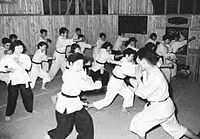"Kempo" redirects here. For Japanese era, see
Kempo (era).
Kenpō|

Japanese men and women practicing kenpo, circa 1955. |
| Also known as |
Kempo |
|---|
| Focus |
Striking |
|---|
| Country of origin |
 Japan Japan |
|---|
| Creator |
Unknown |
|---|
Kenpō (拳法) is the name of several Japanese martial arts. The word kenpō is a Japanese translation of the Chinese word "quán fǎ". This term is also sometimes transliterated as "kempo", as a result of applying Traditional Hepburn romanization,[1] but failing to use a macron to indicate the long vowel. The generic nature of the term combined with its widespread, cross-cultural adoption in the martial arts community has led to many divergent definitions.[2]
Characteristics
Kenpo is firmly undogmatic, and as such its techniques vary depending upon the preference of the practitioner and the instructor. However, certain characteristics are common to nearly all forms of kenpo.
- Kenpo is a system of self-defense. Its techniques are almost entirely counters; typical schools of kenpo do not teach its students how to attack people.
- Kenpo is not about fighting. A Kenpo practitioner does not "feel out" his opponent. Once the kenpo practitioner is attacked, his aim is to end the fight however he can as quickly and efficiently as possible.
- Kenpo is set apart from many other martial arts by the sheer size of its curriculum. This varies, of course, from school to school, but several forms and defenses against strikes, weapons, and grabs, are required to advance in rank.
- Kenpo employs a belt ranking system, similar to those of Karate and Judo.
- Kenpo is almost exclusively a stand-up martial art, using various hand strikes, kicks, elbows, knees, throws, and in some cases joint locks.
Okinawan Kenpo
Some Okinawan martial arts groups use the term kenpō as an alternate name for their karate systems or for a distinct but related art within their association. This can be illustrated by the official full name of Motobu-ryu style named as "Nihon Denryu Heiho Motobu Kenpo" ("Japan's traditional tactics Motobu Kenpo") and by the International Shorin-ryu Karate Kobudo Federation,[3] where Shōrin-ryū is the actual karate style practiced, whereas "hakutsuru kenpo", or "hakutsuru kenpo karate" is a related but distinctive style also taught by the association. Both the "n" and "m" romanizations are used by various groups.
Hawaiian Kenpo
Kenpo has also been appropriated as a modern term: a name for multiple martial arts that developed in Hawaii due to cross-cultural exchange between practitioners of Okinawan martial arts, Chinese martial arts, Japanese martial arts and multiple additional influences.[4] In the United States, kenpo is often referred to as Kenpo Karate. The most widespread styles have their origin in the teachings of James Mitose and William Kwai Sun Chow. Mitose spent most of his early years training in Japan learning his family style, Kosho-Ryū (Old pine tree school). James Mitose would later bring that style to Hawaii where he would teach Chow, who would go on to instruct Ed Parker and Bobby Lowe. The system of kenpo taught by Mitose employed hard linear strikes and kicks, pressure point manipulation, circular movement patterns, and joint locking and breaking.
Parker is the most prominent name in the Mitose lineage. A student of Chow in Hawaii for nearly six months, Parker moved to the US mainland to attend Brigham Young University. In 1957, he began teaching the kenpo that he had learned from Chow, and throughout his life modified and refined the art until it became Ed Parker's American Kenpo.[5] It employs a blend of circular movements and hard linear movements. Parker created techniques with names such as Thundering Hammers, Five Swords, Prance Of The Tiger, and Flashing Mace to provide a memorization tool to the student.
These arts have spread around the world through multiple lineages, not all of which agree on a common historical narrative.
See also
References
External links
 |
Wikimedia Commons has media related to Kenpo. |
